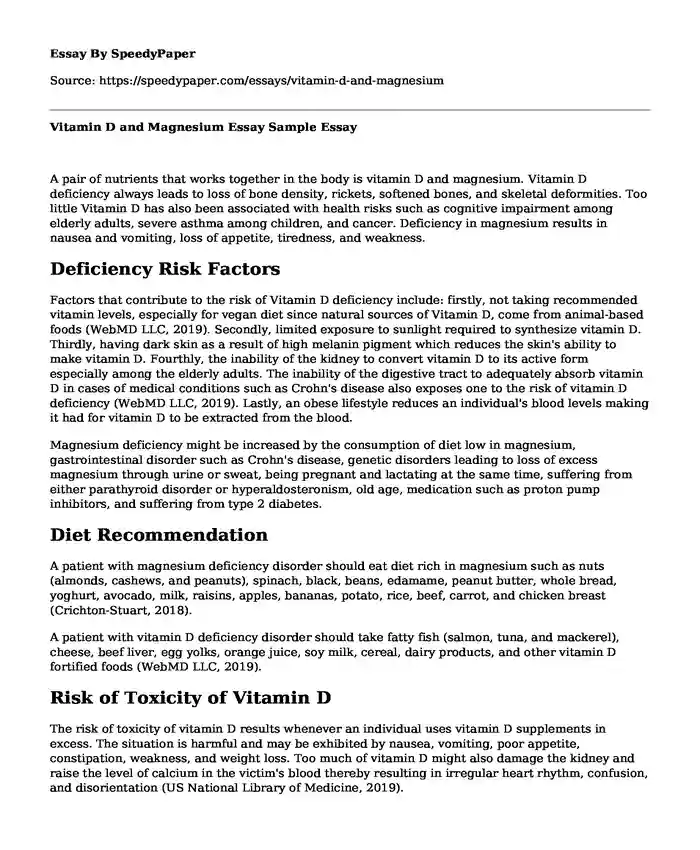
| Type of paper: | Essay |
| Categories: | Pharmacology Healthcare Nutrition |
| Pages: | 3 |
| Wordcount: | 619 words |
A pair of nutrients that works together in the body is vitamin D and magnesium. Vitamin D deficiency always leads to loss of bone density, rickets, softened bones, and skeletal deformities. Too little Vitamin D has also been associated with health risks such as cognitive impairment among elderly adults, severe asthma among children, and cancer. Deficiency in magnesium results in nausea and vomiting, loss of appetite, tiredness, and weakness.
Deficiency Risk Factors
Factors that contribute to the risk of Vitamin D deficiency include: firstly, not taking recommended vitamin levels, especially for vegan diet since natural sources of Vitamin D, come from animal-based foods (WebMD LLC, 2019). Secondly, limited exposure to sunlight required to synthesize vitamin D. Thirdly, having dark skin as a result of high melanin pigment which reduces the skin's ability to make vitamin D. Fourthly, the inability of the kidney to convert vitamin D to its active form especially among the elderly adults. The inability of the digestive tract to adequately absorb vitamin D in cases of medical conditions such as Crohn's disease also exposes one to the risk of vitamin D deficiency (WebMD LLC, 2019). Lastly, an obese lifestyle reduces an individual's blood levels making it had for vitamin D to be extracted from the blood.
Magnesium deficiency might be increased by the consumption of diet low in magnesium, gastrointestinal disorder such as Crohn's disease, genetic disorders leading to loss of excess magnesium through urine or sweat, being pregnant and lactating at the same time, suffering from either parathyroid disorder or hyperaldosteronism, old age, medication such as proton pump inhibitors, and suffering from type 2 diabetes.
Diet Recommendation
A patient with magnesium deficiency disorder should eat diet rich in magnesium such as nuts (almonds, cashews, and peanuts), spinach, black, beans, edamame, peanut butter, whole bread, yoghurt, avocado, milk, raisins, apples, bananas, potato, rice, beef, carrot, and chicken breast (Crichton-Stuart, 2018).
A patient with vitamin D deficiency disorder should take fatty fish (salmon, tuna, and mackerel), cheese, beef liver, egg yolks, orange juice, soy milk, cereal, dairy products, and other vitamin D fortified foods (WebMD LLC, 2019).
Risk of Toxicity of Vitamin D
The risk of toxicity of vitamin D results whenever an individual uses vitamin D supplements in excess. The situation is harmful and may be exhibited by nausea, vomiting, poor appetite, constipation, weakness, and weight loss. Too much of vitamin D might also damage the kidney and raise the level of calcium in the victim's blood thereby resulting in irregular heart rhythm, confusion, and disorientation (US National Library of Medicine, 2019).
The Solubility of Vitamin D
Vitamin D is a fat-soluble vitamin. It is soluble in either fats or lipids commonly referred to as chylomicrons. Once dissolved, the vitamin is transported through the small intestine's lymphatic system into the bloodstream.
Measuring the Level of Vitamin D in the Body
The amount of vitamin D in the body can be measured using a 25-hydroxy vitamin D blood test. The result of the test will show the amount of 25-hydroxyvitamin D in a patient's blood which is an indicator of the amount of vitamin D in the body (WebMD LLC, 2019). That is, the amount of vitamin D can be normal, too high, or too low. Therefore, less than 30 nmol/L will indicate vitamin D deficiency, between 30 nmol/L and 50 nmol/L indicate potential vitamin D deficiency, 50 nmol/L to 125 nmol/L indicate normal levels and over 125 nmol/L indicate high levels (WebMD LLC, 2019).
References
Crichton-Stuart, C. (2018). How can I tell if I have low magnesium? Retrieved from https://www.medicalnewstoday.com/articles/322191.php
US National Library of Medicine. (2019). Vitamin D deficiency. Retrieved from https://medlineplus.gov/vitaminddeficiency.html
WebMD LLC. (2019). Vitamin D deficiency. Retrieved from https://www.webmd.com/diet/guide/vitamin-d-deficiency#1
Cite this page
Vitamin D and Magnesium Essay Sample. (2022, Nov 24). Retrieved from https://speedypaper.net/essays/vitamin-d-and-magnesium
Request Removal
If you are the original author of this essay and no longer wish to have it published on the SpeedyPaper website, please click below to request its removal:
- Free Essay on the Paperless Debate
- Essay Example for You: Race and Ethnicity
- Essay Sample on Medical Imaging Segmentation
- Free Essay Sample on Finance-related Stress Relief
- Naturalistic Observation - Essay Sample on Eye Contact
- Comparison Essay Example: ASUS ROG G55VW and MacBook Pro 15-inch screen
- Research Paper on Lavender for Anxiety: Systematic Review & Meta-Analysis
Popular categories




